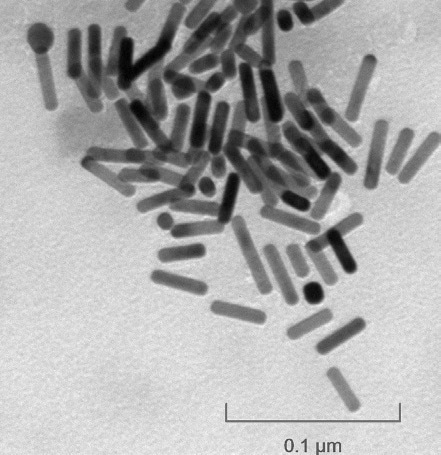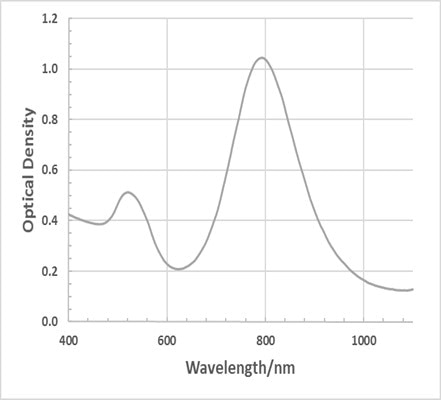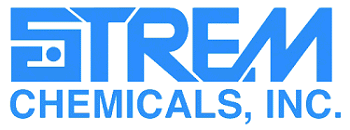This article briefly shows how gold nanorods (GNRs) are produced without using cetyltrimethylammonium bromide (CTAB). The unique surfactant technology supports the synthesis of the SONA GNRs, and provides certain benefits when compared to GNRs produced through the CTAB synthesis technique.
Procedure for Re-dispersing Surfactants
These surfactant technologies result in highly stable GNRs. However in certain instances, when a sample of GNR is exposed to lower temperatures (below ambient temperatures for a long duration) the solution will contain precipitated surfactant that can be clearly seen. This has no effect on the proportion of GNRs present in the solution, and it doesn't indicate an irreversible aggregation process through which GNRs are eliminated – a phenomenon that is usually seen with other GNRs prepared with the CTAB method.
Homogenization of Solutions
The following protocols can be used for homogenizing the solutions:
650, 700, and 750 nm wavelengths: A vial filled with GNRs is placed in a warm water bath of 30 to 35°C for around 15 minutes; the vial is later removed from the bath. This is then followed by swirling the solution and examining the content for the remaining precipitated surfactant. In case there are visible precipitated surfactants, then the process should be repeated until the solution is completely clear.
800 and 850 nm wavelengths: These GNRs are prepared using surfactants that exhibit longer non-polar chains. As a result, an extended warming time will be needed to homogenize the solutions. The vial filled with the GNR solution is transferred to a warm water bath of 45°C and sustained for a period of 20 to 25 minutes. The vial is then removed from the bath, the solution is gently swirled (it will look like a thick gel), and the contents are finally examined for precipitated surfactant. Further warming may be required if high rheology surfactant is present in the solution. Warming can be done for approximately 15 minutes at 45°C until the solution clears completely. It should be noted that during the heating process, the solution may appear to be clear, but when the solution is swirled the surfactant will emerge from the solution. When the swirled solution traps air bubbles inside the viscoelastic gel, instead of preventing the surfactant from precipitating out, it is considered to be homogenized.
Additional Product Details
GNRs are small particles, and their surface plasmon resonance frequencies can be modified as a function of aspect ratio. This imparts optical properties to these particles, enabling them to be used in a wide range of applications; from the electromagnetic spectrum of the visible infrared region to the near- infrared region. GNRs have been employed in many biomedical applications, for instance, they have been used as contrast agents for their hyperthermal effects and optical biomedical imaging.
A barrier when applying GNR-based materials, especially for in-vivo applications including hyperthermal cancer treatment, is the efficient exchange and removal of CTAB, a surfactant that is widely used in large-scale production of GNRs. CTAB is also a cytotoxic and cationic surfactant, and has a low critical concentration of micelles. Its use in the development of GNRs is still a much debated topic, however it is believed that CTAB creates a powerful adsorbed bilayer over the growing gold particle surface. To synthesize gold particles the CTAB concentration is generally 0.10 M, or 100 times its critical micelle concentration. This means a considerable quantity of CTAB still remains in the solution even after the synthesis of GNRs. This helps to stabilize the GNRs, and prevents them from aggregating in the solution.
While critical for GNR synthesis, the CTAB surfactant presents certain limitations to in-vivo applications. Several techniques have been applied to partially exchange or remove the CTAB, including recurrent solvent washing and treatments with surface active materials like PEGylated thiols and other polymers. However during the surfactant exchange, CTAB-coated GNR dispersions are always destabilized. This leads to particle aggregation, and a reduced recovery yields of GNRs. Residual CTAB is often present in the surface-modified GNRs.
Specifications of Gold Gemini Nanorods Kit, CTAB Free
The following are the specifications of the CTAB-free Gold Gemini Nanorods Kit:
- Storage conditions: Should be stored at 4°C to 8°C, but should not be frozen.
- Stabilizer: Amphiphilic
- pH: 5.5 - 7.5
- Concentration: > 30 µg/ml
- Optical Density: 1.0 - 1.2
- Agents solvent: Stabilized with amphiphilic agents in conductivity grade water (18.0 MΩ cm- 1)
- Shelf life: 12 months
Figure 1 shows the CTAB-free Gold Gemini Nanorods (wavelength 800 nm).


Figure 1. Gold Gemini Nanorods, CTAB Free (Wavelength 800 nm)
Each kit comprises the following:
| 79-7010 |
Gold Gemini Nanorods, CTAB Free (Wavelength 650 nm) |
5 ml |
| 79-7015 |
Gold Gemini Nanorods, CTAB Free (Wavelength 700 nm) |
5 ml |
| 79-7020 |
Gold Gemini Nanorods, CTAB Free (Wavelength 750 nm) |
5 ml |
| 79-7025 |
Gold Gemini Nanorods, CTAB Free (Wavelength 800 nm) |
5 ml |
| 79-7030 |
Gold Gemini Nanorods, CTAB Free (Wavelength 850 nm) |
5 ml |
Besides the above sizes, additional sizes are also provided upon request.
| Product Number |
LPSR Maximum (nm) |
Length (nm) |
Width (nm) |
Aspect Ratio |
Color & Form |
| 79-7010 |
640 – 670 |
25 – 31 |
13 – 18 |
1.7 - 1.9 |
Violet liquid |
| 79-7015 |
685 – 715 |
37 – 43 |
13 – 18 |
2.4 - 2.8 |
Blue liquid |
| 79-7020 |
735 – 765 |
37 – 44 |
10 – 13 |
3.4 - 3.7 |
Red-purple liquid |
| 79-7025 |
785 – 815 |
40 – 50 |
10 – 13 |
3.8 - 4.1 |
Red-orange liquid |
| 79-7030 |
835 – 865 |
48 – 55 |
9 – 12 |
4.6 - 5.3 |
Maroon-purple liquid |

This information has been sourced, reviewed and adapted from materials provided by Strem Chemicals.
For more information on this source, please visit Strem Chemicals.